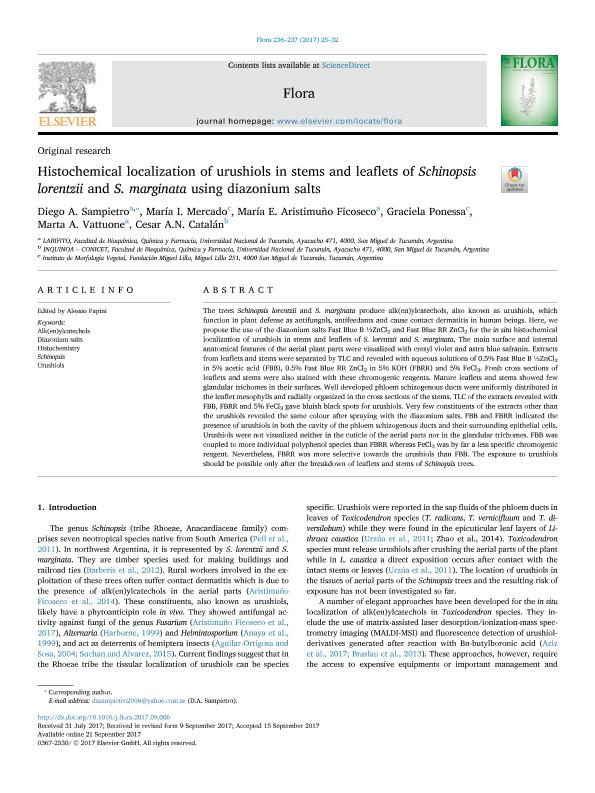Artículo
Histochemical localization of urushiols in stems and leaflets of Schinopsis lorentzii and S. marginata using diazonium salts
Sampietro, Diego Alejandro ; Mercado, Maria Ines
; Mercado, Maria Ines ; Aristimuño Ficoseco, Maria Eugenia del Milagro
; Aristimuño Ficoseco, Maria Eugenia del Milagro ; Ponessa, Graciela; Vattuone, Marta Amelia
; Ponessa, Graciela; Vattuone, Marta Amelia ; Catalan, Cesar Atilio Nazareno
; Catalan, Cesar Atilio Nazareno
 ; Mercado, Maria Ines
; Mercado, Maria Ines ; Aristimuño Ficoseco, Maria Eugenia del Milagro
; Aristimuño Ficoseco, Maria Eugenia del Milagro ; Ponessa, Graciela; Vattuone, Marta Amelia
; Ponessa, Graciela; Vattuone, Marta Amelia ; Catalan, Cesar Atilio Nazareno
; Catalan, Cesar Atilio Nazareno
Fecha de publicación:
11/2017
Editorial:
Elsevier Gmbh
Revista:
Flora
ISSN:
0367-2530
Idioma:
Inglés
Tipo de recurso:
Artículo publicado
Clasificación temática:
Resumen
The trees Schinopsis lorentzii and S. marginata produce alk(en)ylcatechols, also known as urushiols, which function in plant defense as antifungals, antifeedants and cause contact dermatitis in human beings. Here, we propose the use of the diazonium salts Fast Blue B ½ZnCl2 and Fast Blue RR ZnCl2 for the in situ histochemical localization of urushiols in stems and leaflets of S. lorentzii and S. marginata. The main surface and internal anatomical features of the aerial plant parts were visualized with cresyl violet and astra blue safranin. Extracts from leaflets and stems were separated by TLC and revealed with aqueous solutions of 0.5% Fast Blue B ½ZnCl2 in 5% acetic acid (FBB), 0.5% Fast Blue RR ZnCl2 in 5% KOH (FBRR) and 5% FeCl3. Fresh cross sections of leaflets and stems were also stained with these chromogenic reagents. Mature leaflets and stems showed few glandular trichomes in their surfaces. Well developed phloem schizogenous ducts were uniformly distributed in the leaflet mesophylls and radially organized in the cross sections of the stems. TLC of the extracts revealed with FBB, FBRR and 5% FeCl3 gave bluish black spots for urushiols. Very few constituents of the extracts other than the urushiols revealed the same colour after spraying with the diazonium salts. FBB and FBRR indicated the presence of urushiols in both the cavity of the phloem schizogenous ducts and their surrounding epithelial cells. Urushiols were not visualized neither in the cuticle of the aerial parts nor in the glandular trichomes. FBB was coupled to more individual polyphenol species than FBRR whereas FeCl3 was by far a less specific chromogenic reagent. Nevertheless, FBRR was more selective towards the urushiols than FBB. The exposure to urushiols should be possible only after the breakdown of leaflets and stems of Schinopsis trees.
Palabras clave:
Alk(En)Ylcatechols
,
Diazonium Salts
,
Histochemistry
,
Schinopsis
,
Urushiols
Archivos asociados
Licencia
Identificadores
Colecciones
Articulos(CCT - NOA SUR)
Articulos de CTRO.CIENTIFICO TECNOL.CONICET - NOA SUR
Articulos de CTRO.CIENTIFICO TECNOL.CONICET - NOA SUR
Citación
Sampietro, Diego Alejandro; Mercado, Maria Ines; Aristimuño Ficoseco, Maria Eugenia del Milagro; Ponessa, Graciela; Vattuone, Marta Amelia; et al.; Histochemical localization of urushiols in stems and leaflets of Schinopsis lorentzii and S. marginata using diazonium salts; Elsevier Gmbh; Flora; 236-237; 11-2017; 25-32
Compartir
Altmétricas



